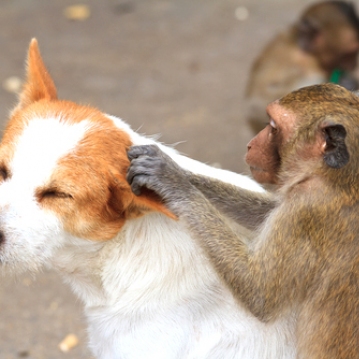
The three most common types of canine allergy are:
1) Flea bite hypersensitivity (aka: flea allergy)
2) Atopy (also known as atopic disease or atopic dermatitis)
3) Food hypersensitivity (aka: food allergy)
- Flea bite hypersensitivity is when the flea injects its saliva into its bite during feeding to prevent clotting of its host´s blood. (yuck) The flea saliva is what dogs and cats are allergic to. Keep in mind, flea-bite hypersensitivity usually gets worse throughout the dogs life. Each year you can expect the allergy will start earlier and last longer in "flea season" and the itching will be more severe.
- Atopy-(atopic disease-AD) in dogs is similar to hay fever in humans. Dogs with AD may be allergic to pollen, mold spores, dust, dust mite droppings, and other common environmental antigens.
All dogs (like humans) will experience an occasional itch. But, dogs with AD will stop in the middle of eating or playing in order to scratch or chew themselves; it will be difficult to interrupt them or prevent them from scratching or chewing intently. The most common areas are on the feet (which are licked or chewed); face (which they will rub against carpet or furniture); and tummy and groin areas which are licked and armpits are scratched.
-Food hypersensitivity-A true allergy to foods is less common than many dog owners believe. According to one study, dogs who suffer from food allergy -almost half also exhibit other hypersensitivities, complicating the diagnostic picture.
Every day I have dog owners ask me to help them with their dog without actually seeing the dog. This would be like you going to your car mechanic and asking "why is my car making this weird noise?" Without actually bringing your car in for the mechanic to evaluate. It is extremely difficult.
So, lets explain what the clinical signs of food allergy may look like:
The skin is most frequently involved with generalized itchiness, bumps, and hotspots. A lot of times the ear or ears may be affected with a foul smell and a brown discharge. Some dogs may even suffer from gastrointestinal symptoms, including diarrhea, vomiting, gassiness, and cramping.
Ok, so now what? Ideally, eliminating the problem from the animals environment would be bestbut not always easy. I would suggest observing any hypersensitivity to any substance-eliminate it from the animal or animals environment, observing an improvement in the animals condition, and reintroducing it with a resulting resumption of signs of allergy. Then prevent the dogs contact with that substance forever. Someone can casually hand your dog a treat he´s not suppose to have and ruin weeks of carefully constructed food elimination trial. A friend can bring her dog over with fleas and unbeknownst to you, bites your dog-which could make you suspect your dog´s current food by mistake.
Identification of the substance or substances to which a dog is hypersensitive requires absolute diligence and daily observation from the dogs owner and an alert, interested veterinarian.
I am personally very fond of Dr.
Robin Valentine. She is a holistic veterinarian in Boca Raton. With an astute veterinarian, they will be able to formulate likely theories about a dogs allergic triggers based on the information you provide. One more reason to keep a daily journal of your dogs health!
